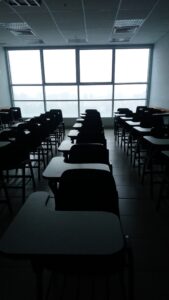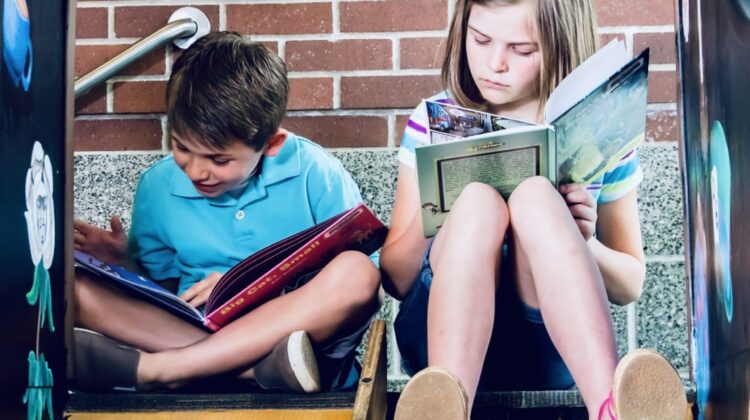
Effects of COVID-19 on children’s literacy levels worldwide
After COVID-19 struck in January 2020, schools were some of the first institutions to close as wave upon wave of restrictions and lockdowns were applied globally. With such a sudden discontinuation of many children’s schooling, the effects of the pandemic on the learning and development have been dramatic.
School closures occurred in a period of development essential for learning language and literacy skills. Taking stock of the damage, UNESCO (United Nations Educational, Scientific and Cultural Organization) have released a report outlining that reading skills in children in lower primary school will have severely fallen behind due to these closures [1].
When estimating the percentage of children that should be proficient in reading by the time they are in Grade 3 at school at the start of the pandemic, the total came to 59%. After the pandemic, they have predicted a 10% drop due to the fact that many children’s essential literacy training was vastly reduced or halted entirely since school closures began. They have shockingly reported that 100 million children now fall below the minimum proficiency level in reading, and that these learners will most likely take years to catch up to pre-pandemic proficiency levels.
How successful has online teaching really been?
 Unfortunately, those who were actually able to attend online classes show evidence that there is no replacement for in-class teaching, for most children. Data is now available to compare pre- and post-pandemic academic outcomes in the wealthy USA, where the majority of children shifted to online teaching, and delays are in evidence in essential skills such as reading fluency [2] and mathematics [3].
Unfortunately, those who were actually able to attend online classes show evidence that there is no replacement for in-class teaching, for most children. Data is now available to compare pre- and post-pandemic academic outcomes in the wealthy USA, where the majority of children shifted to online teaching, and delays are in evidence in essential skills such as reading fluency [2] and mathematics [3].
Although schools in more affluent communities were able to move their activities online , it is important to remember this alternative to traditional schooling was not globally applied. Many children’s education simply came to a halt, particularly in the poorest countries, where education is a primary source of economic and social upliftment.
Can we ever catch up?
As vaccines are rolled out, physical attendance in the classroom is already being phased back in, either partially (e.g. Sweden) or fully (e.g. United Kingdom). Now is the time when a concerted effort will need to be made to catch up what has been missed in order to minimize the long-term damage for children’s future outcomes.
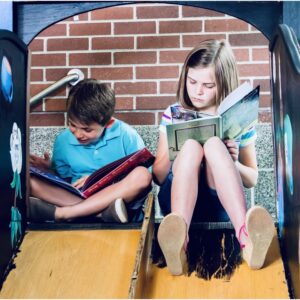 The children that are most likely to struggle with catching up, under most circumstances, have impairments and/or socioeconomic disadvantages. But children that were simply behind in reading already before the pandemic started are also high risk. Home support plays an essential part in making up the deficit. In addition to making sure their children are reading and being read to, free online reading intervention programs such as Abracadabra, Sight Words and ReadWorks can be delivered by parents to support these essential home-based educational activities.
The children that are most likely to struggle with catching up, under most circumstances, have impairments and/or socioeconomic disadvantages. But children that were simply behind in reading already before the pandemic started are also high risk. Home support plays an essential part in making up the deficit. In addition to making sure their children are reading and being read to, free online reading intervention programs such as Abracadabra, Sight Words and ReadWorks can be delivered by parents to support these essential home-based educational activities.
However, a lot of the potential to make up the deficit will be determined by the environment that is being returned to. Schools need to invest in their buildings post-pandemic to make sure that they make up this gap in literacy. Unfortunately, in the majority of schools, the opportunity the pandemic’s empty schools provided to refurbish and rejuvenate the classroom was not embraced. Consequently children, in most cases, will return to the same sub-standard acoustic environments that they left. But what does this mean for their potential to catch up when literacy lags behind?
Links between the sound environment and reading
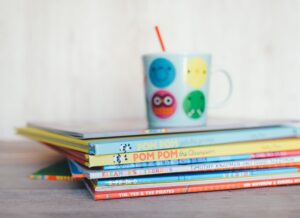 The relationship between classroom acoustics and reading are indirect. Reading and hearing link up via an intermediary, namely speech perception. Children with a normally functioning auditory system learn how to speak before they learn how to read. Speech input is therefore the first channel through which they learn their primary language, with reading coming later. Thereafter, the processes of hearing, speech perception and reading are inseparably dependent.
The relationship between classroom acoustics and reading are indirect. Reading and hearing link up via an intermediary, namely speech perception. Children with a normally functioning auditory system learn how to speak before they learn how to read. Speech input is therefore the first channel through which they learn their primary language, with reading coming later. Thereafter, the processes of hearing, speech perception and reading are inseparably dependent.
The dependency between speech and reading is evident in the fact that while people of all ages read, they speak out the words silently. This process, called “subvocalization”, is imperceptible to the naked eye. However, the entire vocal tract is actually producing minute movements of the body parts used in the articulation of speech during reading [4]. It should not come as much of a surprise then that relationships have been found between children’s reading abilities, and how well they are able to hear speech sounds and encode speech in the brain [5].
Because factors that influence the quality of the speech input a child receives in the classroom determines later language and reading abilities, indoor acoustics need to be considered. This is because good room acoustics amplify the parts of speech that are most beneficial for us to hear – higher frequency consonant sounds for example – while bad room acoustics enhance sounds inside a room that mask the all-important speech signal. Given that children need to be able to hear speech properly in order to develop the foundational phonological skills they later apply to reading, a good sound environment becomes of paramount importance. Acoustics hold power over the transmission and perception of speech in two fundamental ways: improving the clarity of speech and lowering noise levels in the classroom.
Better speech clarity
When speech sounds are projected out from a speaker in a room, reflections from the ceilings and walls can either detract from what is being said or reinforce it. The determining factor is time. Those reflections that arrive quickest (<50 ms) have a reinforcing effect because they are perceived as occurring simultaneously with the sound that comes directly from the mouth of the speaker.
Meanwhile, those reflections that come after the 50ms boundary increasingly mask the target sound by creating an echo-effect that becomes more audible – and disturbing – in proportion with how long it takes for them to reach us after the direct sound. This is why the room acoustic measure of speech clarity (C50) compares the amount of energy in a room that is reflected prior to 50ms (called “early reflections”) with the amount of energy which comes after (called “late reflections”). The more this ratio is in favour of early reflections, the easier it is for the children in the room listen, understand and remember what is being said.
Lower classroom noise-levels
In addition to improving the clarity of speech, strategies for impeding the amount of sound energy in a room also need to be applied by classroom acousticians. When reflections build up in an enclosed space without absorbent materials on the ceilings and walls, the level of noise within a room is drastically higher. Classroom acoustic environments are naturally noisy already due to the activities that take place within them, and they are becoming ever-noisier due to modern teaching methods. This presents ever-greater challenges for the perception of speech on the back of which reading abilities develop, and necessitates some intervention in order to reduce the noise to an acceptable level for speech perception.
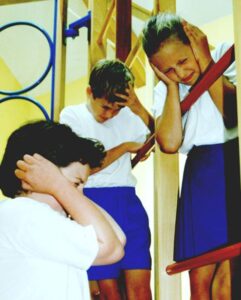 Noise reduces the intelligibility of speech for children and adults alike, but the ability to deal with the challenges of noise for our auditory system improves as we get older [6]. This means that children are already placed at a disadvantage from the offset. Language abilities can only develop when there is successful language input (ie. comprehension). This is why the likelihood of developing a delay in language and reading later on can and has been predicted statistically by a child’s ability to hear speech despite the presence of noise (eg. [7]).
Noise reduces the intelligibility of speech for children and adults alike, but the ability to deal with the challenges of noise for our auditory system improves as we get older [6]. This means that children are already placed at a disadvantage from the offset. Language abilities can only develop when there is successful language input (ie. comprehension). This is why the likelihood of developing a delay in language and reading later on can and has been predicted statistically by a child’s ability to hear speech despite the presence of noise (eg. [7]).
There are also clinical subgroups of children within the classroom that are even less able to cope with noise, such as those with sensory processing problems such as hearing loss and auditory processing disorder as well as special education needs (eg. dyslexia, autism spectrum disorder). Additionally, non-clinical sub-groups often get forgotten when considering those at risk in a poor sound environment. This includes children learning in a foreign language, who cannot make out what is being communicated even though they might have good hearing and speech perception in their first language. For these groups of children the noise burden is far higher, and it is likely that they were exhibiting poorer reading skills prior to the pandemic already compared with their first-language learner peers, compounding the effects of school closures on literacy.
Improved classroom acoustics need to be an essential part of the post-pandemic catch-up strategy
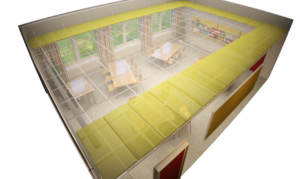 When one considers how much of children’s language learning is done in noisy classroom environments, the implications for literacy development become crystal clear. Those children that are better able to understand speech when the sound environment becomes challenging are likely to get much more language input from the people around them and race ahead developmentally, which has a downstream effect on reading ability. Meanwhile, those with preexisting sensory impairments, special education needs and reading delays fall further behind in environments that make success an impossibility.
When one considers how much of children’s language learning is done in noisy classroom environments, the implications for literacy development become crystal clear. Those children that are better able to understand speech when the sound environment becomes challenging are likely to get much more language input from the people around them and race ahead developmentally, which has a downstream effect on reading ability. Meanwhile, those with preexisting sensory impairments, special education needs and reading delays fall further behind in environments that make success an impossibility.
In conclusion, the only way to create equal potential for every child in the classroom to catch up is to make the sound environment as conducive to learning as it can be for everyone in it. The only thing that remains is for schools to consider whether the expense of refurbishment, or building correctly from the beginning, is justification enough to ignore the developmental boost that the classroom environment can provide to children catching up post-pandemic.
Sources
[1] UNESCO. (2021). Pandemic-related disruptions to schooling and impacts on learning proficiency indicators: A focus on the early grades. Accessed at: http://uis.unesco.org/sites/default/files/documents/covid-19_interruptions_to_learning_-_final.pdf
[2] Domingue, B. W., Hough, H. J., Lang, D., & Yeatman, J. (2021). Changing Patterns of Growth in Oral Reading Fluency During the COVID-19 Pandemic. PACE.
[3] Kuhfeld, M., Tarasawa, B., Johnson, A., Ruzek, E., & Lewis, K. (2020). Learning during COVID-19: Initial findings on students’ reading and math achievement and growth. NWEA.
[4] Rayner, K. & Pollatsek, A. (1994). The Psychology of Reading. Psychology Press.
[5] Hornickel, J., Skoe, E., Nicol, T., Zecker, S., & Kraus, N. (2009). Subcortical differentiation of stop consonants relates to reading and speech-in-noise perception. Proceedings of the National Academy of Sciences, 106(31), 13022-13027.
[6] Moore, B. C. (2012). An introduction to the psychology of hearing. Brill.
[7] Boets, B., Wouters, J., Van Wieringen, A., & Ghesquière, P. (2006). Auditory temporal information processing in preschool children at family risk for dyslexia: Relations with phonological abilities and developing literacy skills. Brain and Language, 97(1), 64-79.
Author: Douglas MacCutcheon, Global Concept Developer for Educational Environments at Ecophon

